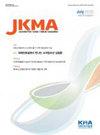生物制品治疗慢性荨麻疹
IF 0.5
Q3 MEDICINE, GENERAL & INTERNAL
引用次数: 0
摘要
背景:慢性荨麻疹的特征是反复出现痒疹和/或血管性水肿至少6周。慢性荨麻疹的患病率在全球范围内呈上升趋势,不同地区之间存在差异。慢性荨麻疹持续时间长,并可能随时间复发。由于不可预测、反复发作和致残的症状以及对生活质量的重大影响,对此类患者进行有效和可耐受的治疗至关重要。当前概念:最近的指南建议定期使用非镇静的第二代抗组胺药作为慢性荨麻疹的一线治疗。对于使用批准剂量的抗组胺药后荨麻疹症状持续或恶化的患者,指南建议采用二线治疗,即增加初始抗组胺药的剂量或与其他三种抗组胺药联合使用。然而,几乎一半的慢性荨麻疹患者对抗组胺药是难治的。最近,调节免疫球蛋白E (IgE)水平和活性的治疗被发现提供了一种有效的治疗方法。Omalizumab是迄今为止唯一被批准用于慢性荨麻疹患者的抗ige治疗药物,已证明其有效性和安全性。最近的国际指南推荐omalizumab作为抗组胺难治性慢性自发性荨麻疹的首选治疗。讨论和结论:由于omalizumab不是一种治疗和疾病改善药物,有一小部分慢性自发性荨麻疹患者对omalizumab部分或从未有反应。为了解决这个问题,正在进行的研究正在探索其他针对不同方面的生物制品的治疗潜力,如2型炎症、补体系统和c-kit途径。本文章由计算机程序翻译,如有差异,请以英文原文为准。
Treatment with biological products for chronic urticaria
Background: Chronic urticaria is characterized by repeatedly occurring itchy wheals and/or angioedema for at least six weeks. The prevalence of chronic urticaria is increasing globally, with variations observed among different regions. Chronic urticaria has a long duration and may recur over time. Effective and tolerable treatment for such patients is crucial due to unpredictable, recurrent, and disabling symptoms, as well as the significant impact on quality of life.Current Concepts: Recent guidelines recommend the regular use of non-sedative second generation antihistamines as the first line of treatment for chronic urticaria. For patients whose urticarial symptoms persist or worsen with the approved dose of antihistamines, the guideline recommends the second line of treatment, which involves either increasing the dosage of the initial antihistamine or combining it with three other kinds of antihistamines. However, almost half of patients with chronic urticaria are refractory to antihistamines. Recently, treatment modulating immunoglobulin E (IgE) levels and activities was found to provide an efficient therapeutic approach. Omalizumab, the only approved anti-IgE treatment to date for patients with chronic urticaria, has demonstrated strong evidence of both efficacy and safety. Recent international guidelines recommend omalizumab as the first choice of treatment for antihistamine-refractory chronic spontaneous urticaria.Discussion and Conclusion: As omalizumab is not a curative and disease-modifying agent, there is a subpopulation of patients with chronic spontaneous urticaria who partly or have never responded to omalizumab. To address this, ongoing research is exploring the therapeutic potential of other biological products that target various aspects, such as type 2 inflammation, complement system, and the c-kit pathway.
求助全文
通过发布文献求助,成功后即可免费获取论文全文。
去求助
来源期刊

Journal of The Korean Medical Association
Medicine-General Medicine
CiteScore
0.50
自引率
0.00%
发文量
84
审稿时长
4-8 weeks
期刊介绍:
The Journal of the Korean Medical Association (JKMA) is the official peer-reviewed, open-access, monthly journal of the Korean Medical Association (KMA). It contains articles in Korean or English. Its abbreviated title is ''J Korean Med Assoc''. The aims of the Journal include contributing to the treatment of and preventing diseases of public health importance and to improvement of health and quality of life through sharing the state-of the-art scientific information on medicine by the members of KMA and other national and international societies.
 求助内容:
求助内容: 应助结果提醒方式:
应助结果提醒方式:


